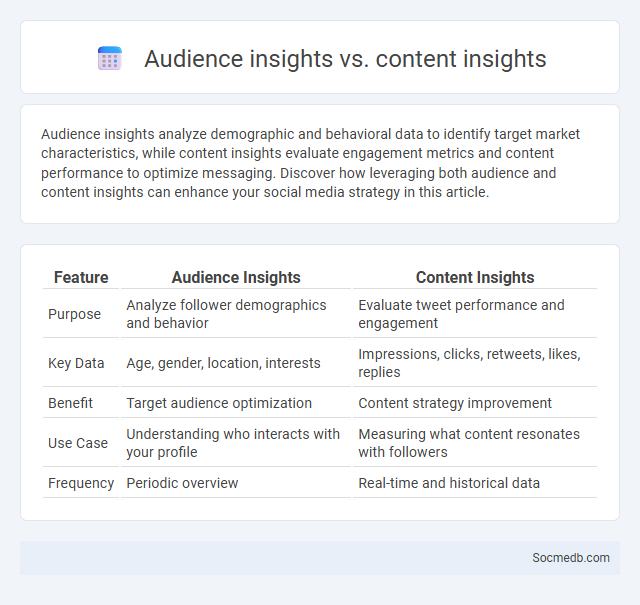
Photo illustration: Audience insights vs content insights
Audience insights analyze demographic and behavioral data to identify target market characteristics, while content insights evaluate engagement metrics and content performance to optimize messaging. Discover how leveraging both audience and content insights can enhance your social media strategy in this article.
Table of Comparison
| Feature | Audience Insights | Content Insights |
|---|---|---|
| Purpose | Analyze follower demographics and behavior | Evaluate tweet performance and engagement |
| Key Data | Age, gender, location, interests | Impressions, clicks, retweets, likes, replies |
| Benefit | Target audience optimization | Content strategy improvement |
| Use Case | Understanding who interacts with your profile | Measuring what content resonates with followers |
| Frequency | Periodic overview | Real-time and historical data |
Understanding Audience Insights: Definition and Importance
Understanding audience insights involves analyzing data on user behavior, preferences, demographics, and engagement patterns across social media platforms. These insights enable marketers to tailor content, optimize targeting strategies, and enhance user experience, resulting in higher engagement rates and improved campaign performance. Leveraging tools like Facebook Audience Insights, Instagram Analytics, and Twitter Analytics provides precise information about audience interests and trends, crucial for informed decision-making in social media marketing.
What Are Content Insights? Key Metrics Unveiled
Content insights are data-driven analytics that reveal how users interact with social media posts, highlighting key metrics such as engagement rate, reach, impressions, and click-through rates. These metrics provide valuable information on audience behavior, content effectiveness, and overall campaign performance. Analyzing content insights enables marketers to optimize strategies and tailor content to maximize user engagement and brand visibility.
The Role of Reports in Data-Driven Decisions
Reports in social media analytics provide critical insights by aggregating user engagement metrics, demographic data, and content performance to guide your marketing strategies. These detailed reports enable you to identify trends, optimize campaigns, and allocate resources more effectively based on real-time data. Leveraging accurate social media reports allows businesses to make informed, data-driven decisions that enhance audience targeting and boost ROI.
Audience Insights vs Content Insights: Core Differences
Audience Insights reveal demographic, geographic, and behavioral data about social media users, enabling precise targeting and personalized campaigns. Content Insights analyze engagement metrics, such as likes, shares, comments, and viewing time, to evaluate the performance and appeal of posts. Understanding the core differences between these insights allows marketers to tailor content strategies effectively while reaching the right audience with maximum impact.
Benefits of Deep Audience Analysis
Deep audience analysis on social media unlocks valuable insights into your followers' demographics, interests, and behaviors, enabling highly targeted content creation and ad campaigns. Understanding these data points enhances engagement rates and boosts conversion by tailoring messages that resonate specifically with your audience's preferences. This strategic approach helps optimize your marketing efforts, improving ROI and fostering stronger brand loyalty.
Leveraging Content Insights for Better Strategy
Analyzing social media content insights reveals valuable patterns in audience engagement, helping you tailor posts to maximize reach and interaction. Identifying high-performing content types and optimal posting times allows for more efficient allocation of resources and improved ROI. Using data-driven strategies based on these insights enhances your social media presence and drives better overall performance.
Integrating Reports: Turning Data into Action
Integrating reports from multiple social media platforms allows you to transform raw data into actionable insights, improving your marketing strategies and audience engagement. By consolidating metrics such as engagement rates, follower growth, and content performance, you can identify trends and optimize your campaigns for better ROI. Leveraging tools that automate report integration enhances accuracy and saves time, empowering your decision-making with comprehensive and up-to-date information.
Tools for Gathering Audience and Content Insights
Social media tools like Sprout Social and Hootsuite provide comprehensive audience analytics, enabling marketers to identify demographics, engagement patterns, and content preferences. Platforms such as Brandwatch and BuzzSumo offer advanced sentiment analysis and trending content insights, helping creators tailor strategies for maximum reach. Utilizing these tools enhances data-driven decisions, optimizing content relevance and audience targeting.
Common Challenges in Interpreting Reports
Interpreting social media reports often involves navigating inconsistent data metrics and distinguishing between genuine user engagement and bot activity. Your analysis can be skewed by algorithm changes or platform-specific biases, making it challenging to derive accurate insights. Understanding these complexities is essential for making informed decisions based on social media analytics.
Best Practices for Combining Insights and Reports
Combining insights and reports from social media analytics enhances your ability to identify key performance trends and audience behaviors critical for strategic growth. Integrate data from multiple platforms to create a holistic view, leveraging engagement rates, follower demographics, and content performance metrics for more accurate decision-making. Use visual dashboards and automated reporting tools to streamline data interpretation and optimize your social media strategy effectively.
 socmedb.com
socmedb.com